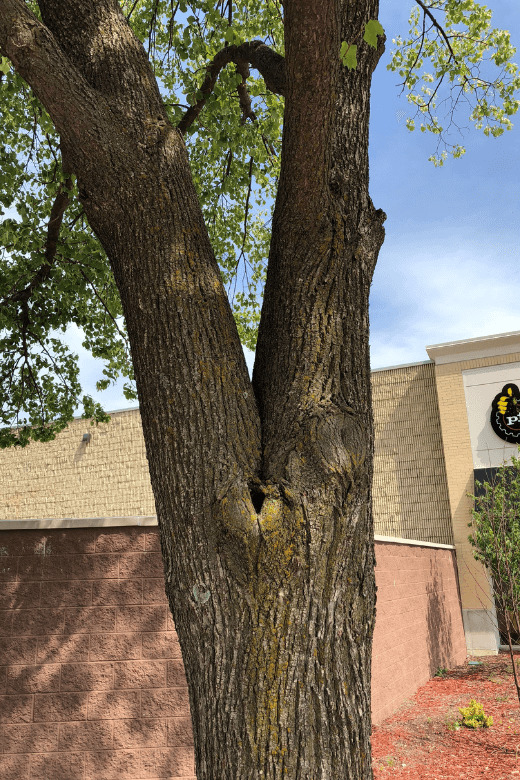Sometimes as trees grow they develop weaknesses that can compromise their structural integrity. This can lead to weakened branches that are at danger of failing, especially in a wind, ice or snow storm.

.
One common weakness that forms in trees is called included bark.
When a tree grows its branches divide at a junction, called a fork. Sometimes, two or more branches emerge from one fork. This creates a weak union where included bark forms.
Included bark lacks the strong fiber needed to create a structurally sound branch union. When included bark is put under stress (think wind, snow load, or even a heavy canopy) it is susceptible to tear.
Included bark is commonly seen when a tree has codominant leaders, or two main branches competing to be the leader. You might notice them as two branches in similar height, growing straight up. Imagine climbing up those two branches, and pushing them apart. Due to the lack of strength in the included bark, they may split at the union.
When these week unions are put under added stress from environmental factors branches can split off due to extra force applied at that union. That’s not a pretty sight. But more importantly, it can be dangerous if cars, houses, powerlines or people are nearby.

Ways to Prevent Weak Branches
There are several steps you can take to avoid the formation of weak unions and some ways to address them if you’ve inherited trees that already suffer from this structural issue.
Pruning from a young age
The ideal course of action to take is to prevent weak unions from forming in the first place.
The best way to avoid included bark is to get your tree pruned by a certified arborist from a young age. A professional will be able to catch the formation of codominant branches (which lead to included bark) and will be able to prune out one of the branches over time to let one branch establish as the leader.
We recommend that all homeowners put their trees on a regular pruning schedule every 3-5 years.
If you wait too long to address a codominant branch and it grows to a large size, removal may not be an option. When a branch is mature and established, removing it may create a wound that would cause an overall health decline in your tree.
Methods for Addressing Weak Branches
Maybe you didn’t read this blog in time or you inherited a property with older trees and you have a large codominant branch with included bark! Don’t worry, we still have some options for addressing weak branches, including tree bracing and cabling.
If one of your trees has included bark it can be supported by various methods.
Synthetic cabling
Synthetic cabling is a minimally invasive procedure that involves securing the co-dominant branches with a soft cable of synthetic fibers. It reduces canopy movement and reduces the likelihood of splitting. It has been shown that this can be just as reliable as steel cables.
Steel cabling
Steel cabling is similar to synthetic cabling, but uses steel wire instead of synthetic fibers.
Tree Bracing
Bracing is used in severe cases when a tree has two prominent leaders. The branches are drilled into and secured with steel wire and bolts. It is more invasive, so we prefer to do synthetic cabling instead. In the worst cases, bracing may need to be supplemented with synthetic cabling.
Tree Removal
While we always prefer to keep trees healthy, thriving and alive, sometimes a tree must be removed for a variety of reasons. In such cases, a certified arborist will ensure that the tree is removed in a safe manner that preserves the structures and landscape on your property and creates positive changes.
If you suspect your tree has included bark and might need some pruning, tree bracing or cabling, invite a Certified Arborist to assess your tree and the risk of branch failure. They can help you decide upon the best plan of action to address the situation.







